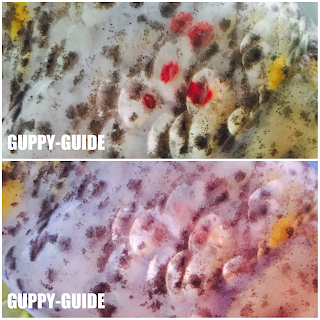If there's one little fish that tends to get a bad reputation in the fish community it's none other than the GloFish so, today I'm here to debunk a few things.
First off, these glowing freshwater fish are generally just danios, barbs, and tetras that have been genetically modified with jellyfish DNA while still unhatched from their egg. When a GloFish breeds its offspring will retain their parents glowing abilities, but if you're trying to mix neon shades through breeding than it's anyone's guess as to what color the offspring will be (I'd assume they take the most dominant gene in terms of colorization rather than combining two different shades). While you can breed these fish they actually have a patent which makes them illegal for you to sell. Therefore the company selling Glofish can technically say that the fish you purchased was not injected directly themselves, but the original fish they created was (although I noticed they don't bluntly state that on signs at Petco).
The GloFish was supposedly created back in 2003 to help detect pollution in water as the GloFish company claims that when these fish are exposed to polluted water containing certain metals, etc it will cause them to glow, while in safe water they wouldn't. For those in the aquarium hobby, you'll notice the fishes glowing effects under a fluorescent light so, no polluted water needed. Also, these fish don't really glow as they actually just absorb light and re-emit it.
A few other concerns I noticed online is the introduction of these fish into the wild and their effects on the environment while also noting that certain temperatures may result in killing these tropical fish while still possibly leaving a few remaining if they happen to find better temperatures in certain areas of their habitat. According to the GloFish company, their fish pose no further risk to the environment than their non-glo counterparts as the DNA gene they're injected with comes from a natural source (With that said I'm going to assume this jellyfish gene came from a freshwater jellyfish rather than saltwater since these are not at all saltwater fish), but it is said that you shouldn't consume these fish (as with most ornamental aquarium fish). Therefore it is said that these pose no threat to wildlife if consumed (I guess that's a different story if a person consumes one directly). According to the Florida Division of Aquaculture, these fish pose no threat to their environment in accordance with the FDA (which can really be a whole different topic on its own but we won't dive that deep in this post).
According to PetMD these fish have the same lifespan as their non-glo family members which is around 3.5 to 5 years, and they require the same habit and diet. Overall, if all this is, in fact, true then there's really no reason not to invest in our modified GloFish friends unless you just enjoy the fish in its original non-modified glory. In which case, there are more naturally neon-colored fish in the wild such as the ever popular neon or cardinal tetra.
First off, these glowing freshwater fish are generally just danios, barbs, and tetras that have been genetically modified with jellyfish DNA while still unhatched from their egg. When a GloFish breeds its offspring will retain their parents glowing abilities, but if you're trying to mix neon shades through breeding than it's anyone's guess as to what color the offspring will be (I'd assume they take the most dominant gene in terms of colorization rather than combining two different shades). While you can breed these fish they actually have a patent which makes them illegal for you to sell. Therefore the company selling Glofish can technically say that the fish you purchased was not injected directly themselves, but the original fish they created was (although I noticed they don't bluntly state that on signs at Petco).
 |
| GloFish at Petco |
A few other concerns I noticed online is the introduction of these fish into the wild and their effects on the environment while also noting that certain temperatures may result in killing these tropical fish while still possibly leaving a few remaining if they happen to find better temperatures in certain areas of their habitat. According to the GloFish company, their fish pose no further risk to the environment than their non-glo counterparts as the DNA gene they're injected with comes from a natural source (With that said I'm going to assume this jellyfish gene came from a freshwater jellyfish rather than saltwater since these are not at all saltwater fish), but it is said that you shouldn't consume these fish (as with most ornamental aquarium fish). Therefore it is said that these pose no threat to wildlife if consumed (I guess that's a different story if a person consumes one directly). According to the Florida Division of Aquaculture, these fish pose no threat to their environment in accordance with the FDA (which can really be a whole different topic on its own but we won't dive that deep in this post).
According to PetMD these fish have the same lifespan as their non-glo family members which is around 3.5 to 5 years, and they require the same habit and diet. Overall, if all this is, in fact, true then there's really no reason not to invest in our modified GloFish friends unless you just enjoy the fish in its original non-modified glory. In which case, there are more naturally neon-colored fish in the wild such as the ever popular neon or cardinal tetra.








